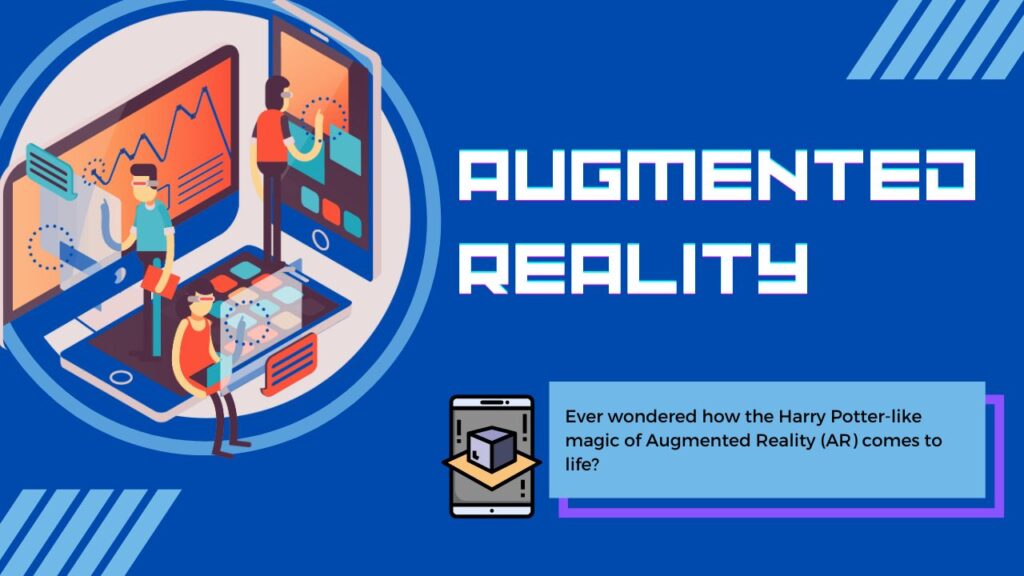Hey there, tech enthusiasts! Ever found yourself caught between the blurred lines of reality and the digital world? Sounds like something out of a sci-fi movie, right? Well, it’s much closer to home than you’d think, thanks to the magic of Augmented Reality (AR). This incredible technology is popping up everywhere, transforming the way we live, learn, and play.

Table of Contents
What is Augmented Reality?
Augmented Reality, or AR as it’s often called, is like an enhanced version of our actual world. It takes our everyday surroundings and jazzes them up with digital goodies like images, sounds, or other sensory stuff, all brought to you through the power of tech.
Picture yourself wearing a pair of high-tech glasses. Now, imagine looking through those glasses and seeing digital information – like directions, product prices, or historical facts about landmarks – layered on top of the real world. Sound futuristic? Well, welcome to the world of augmented reality!
At its core, AR is about enhancing our reality by overlaying digital information – think visual, auditory, or other sensory information – onto our physical world. It’s like adding a high-tech, interactive layer to our everyday life.
Unlike its cousin, Virtual Reality (VR), which whisks users off to completely digital realms, AR keeps one foot firmly in the real world, simply adding a layer of digital magic on top of it.
How Does Augmented Reality Work?
The magic of AR begins with devices such as smart glasses, smartphones, or tablets that contain software, sensors, and a digital projector. These devices capture our real-world environment and overlay digital information onto it.
The software processes the data from the sensors that scan the environment, while the digital projector displays the augmented elements onto a surface or directly into the user’s field of vision. It’s this blend of reality and digital augmentation that creates the unique AR experience.
AR devices are designed with various components including software, sensors, and a digital projector. They’re like little elves tirelessly working behind the scenes to create the immersive and interactive experience of AR. Here’s how they do it:
- Sensors and Cameras: Just like our eyes capture the world around us, sensors and cameras in AR devices scan the surrounding environment. They gather spatial and depth data, assess lighting conditions, and capture real-time movements. This raw data acts as the canvas onto which digital augmentations will be painted.
- Processors: These are the brains of the operation. Similar to the brain in our heads, processors in AR devices analyze data from sensors and cameras. They identify surfaces, objects, and points of interest in the environment. Then, they use this data to create and position digital content accurately in the user’s field of vision.
- Projectors: These are the artists of AR. They take the digital information prepared by the processors and overlay it onto our physical environment. This could be anything from a virtual try-on of a new pair of sneakers to a guided tour of a city’s landmarks.
- Reflectors: They play a crucial role in assisting the projectors. Reflectors in AR devices channel augmented visuals to the user’s eye, helping create a seamless blend of the real world with digital augmentations.
Top AR Use Cases
AR isn’t just for high-tech whizzes or futuristic dreamers. It’s being used in all kinds of exciting ways across various industries.
Here’s a sneak peek into how AR is transforming various fields:
- Shopping with Style: Imagine previewing your dream couch right in your living room without even purchasing it. Online shopping apps let you do just that with AR, making shopping decisions way easier and much more fun!
- Entertainment Unleashed: Ever animated your face into a funny or creative avatar on social media? That’s AR at play! Plus, it’s taking gaming to a whole new level by blending the virtual and real worlds, making games incredibly immersive.
- Next-Level Navigation: Say goodbye to getting lost or missing turns. AR overlays the path to your destination directly onto your live view of the road. Plus, you get handy info about local shops or eateries nearby. It’s like having a knowledgeable local guide right in your car!
- Handyman’s Helper: Need to measure a space but can’t find your tape measure? No worries! Your smartphone, with the help of AR, can measure different points in your surroundings. It’s like having a virtual toolbox right in your pocket!
- Architect’s Assistant: Architects are leveraging AR to visualize their designs in the real world before the construction even begins. It’s like seeing a building rise from the blueprint!
- Warrior’s Aid: AR isn’t just for fun and games; it’s also a vital tool in the military. Vital information, like travel directions, distances, or weather and road conditions, can be displayed right on a vehicle’s windshield.
- Digging into the Past: Archeologists are using AR to reconstruct historical sites, and museum-goers get to explore excavation sites just as if they were part of the original dig. It’s like time travel through the lens of AR!
Differences Between AR and VR
Though they share some similarities and often get mentioned together, AR and VR are distinct. While both can create immersive experiences, the key difference lies in how they interact with reality.
| Augmented Reality (AR) | Virtual Reality (VR) | |
|---|---|---|
| Definition | AR layers digital elements onto the user’s existing environment. | VR immerses the user in a completely artificial, digital environment. |
| Interaction with Reality | AR enhances the real world with digital add-ons. | VR replaces the real world with a digital one. |
| Hardware Required | Smartphones, tablets, AR glasses. | VR headsets, often with controllers. |
| Usage Examples | Navigation aids, virtual shopping, interactive learning. | Gaming, virtual tours, simulated training. |
| User Experience | Users stay connected with the real world while interacting with digital elements. | Users are fully immersed in a virtual world, isolated from the real world. |
| Purpose | More about adding to reality, making certain tasks easier or more entertaining. | More about escaping reality, offering completely new, often fantastical, experiences. |




